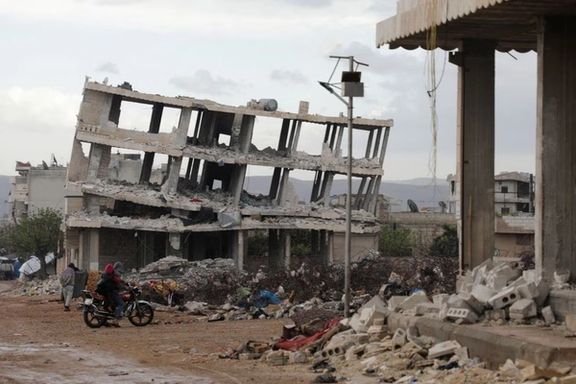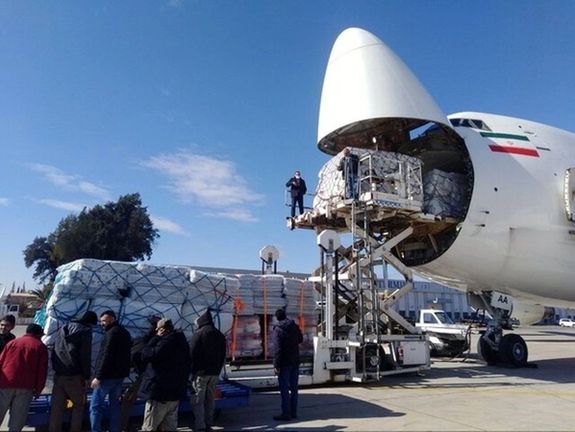Iran Continues To Use Syria’s Earthquake To Ramp Up Military Capabilities

Iran continues to use the opportunity of earthquake relief to smuggle weapons and military equipment into Syria.

Iran continues to use the opportunity of earthquake relief to smuggle weapons and military equipment into Syria.
As regional tensions escalate, including attacks on US and facilities in Syria and rockets launched from both Lebanon and Syria by Iranian proxies into Israel, activities in Syria are ramping up.
The fact that humanitarian relief is not subject to sanctions, makes it all the more easy for Iran to capitalize on the catastrophe, in the region where Tehran’s influence has been on the rise since it began supporting Assad in the civil war that began in 2011.
Syria has become a key battleground between Iran and its enemies, as Iran buttresses the threat from Israel and strengthens the Assad regime. Strikes in recent weeks from Israel have seen key Iranian military figures killed from the Revolutionary Guards and Quds Force, including targeting weapons factories and infrastructure in Iran.
Israel, which has vowed to stop Iranian entrenchment in Syria, has carried out hundreds of strikes in government-controlled parts of that country in recent years, though it rarely acknowledges them.

Before the latest strikes which came in retaliation for rockets launched into the Golan Heights, Syrian officials had attributed 10 attacks to Israel this year, some of which put the Damascus and Aleppo airports temporarily out of service and killed civilians as well as Syrian soldiers and Iranian military advisers.
Israel said artillery and drone strikes last weekend hit rocket launchers in Syria and were followed by airstrikes against a Syrian army compound, military radar systems and artillery posts.
Since the February 6 earthquake in northern Syria and Turkey, hundreds of flights from Iran have been landing in Syria's Aleppo, Damascus and Latakia airports bringing supplies. It has opened the door for Iran to build back after a series of strikes from Israel have targeted the likes of munitions factories.
The supplies being smuggled alongside relief goods have, according to intelligence, included advanced communications equipment and radar batteries and spare parts required for a planned upgrade of Syria's Iran-provided air defence system in its civil war.
While Iran's mission to the United Nations in New York said the allegations are untrue, Israel has stepped up efforts to counter the activity, with multiple attacks on airports in the last six months with most aid delivered to Aleppo airport, a major focus of the strikes.
Speaking to Reuters, Brigadier General Yossi Kuperwasser, a former head of research in the Israel army as well as ex-general director of the Ministry of Strategic Affairs said Israeli air strikes against the shipments relied on intelligence so specific that Israel's military knew which truck in a long convoy to target.

Quds Force is leading the efforts, Unit 18000 Syrian division organising shipments along with the foreign espionage and paramilitary arm of Iran's Revolutionary Guards, led by Hassan Mehdoui (Mahdavi).
Ground transportation was handled by the Quds Force's Transport Unit 190 led by Bahanem Shahariri (Behnam Shahriari), according to intelligence sources speaking to Reuters.
"Israel's strikes also targeted a meeting of commanders of Iranian militias and shipments of electronic chips to upgrade weapons systems," said Syrian military defector Colonel Abduljabbar Akaidi, who retains army contacts. Akaidi did not say where the meeting was held.
Speaking to Reuters, a Syrian army officer who asked not to be named said the Israelis “have information that something is being developed quickly”. The quake created the right conditions and the chaos that ensued allowed Iranian jets to land with ease.
More recently, Israeli strikes have focused on the like of weapons warehouses in the Jabal Manea Kiswa mountain range south of Damascus where Iranian troops and Lebanon's Hezbollah have built what is probably their most fortified military site in Syria.
It is no coincidence, that with Syria being in Iran’s pocket, major regional players are trying to bring Assad in from the cold. From the UAE to Tunisia, diplomatic channels are opening up for the Syrian dictator, which may signal the region’s growing concerns about Syria being Iran’s lapdog.
This also works for Iran. As relations begin to thaw with countries including the UAE and Saudi Arabia, perhaps the region is waking up to the fact that intervention is the only form of prevention of an escalation which is showing no signs of waning.